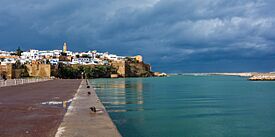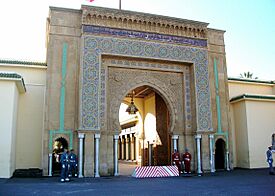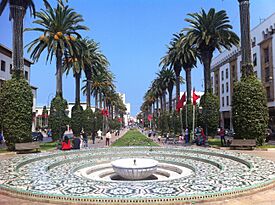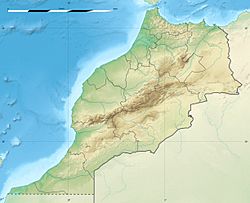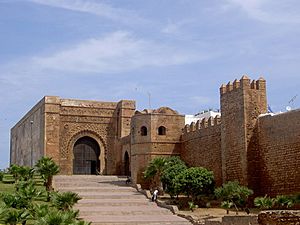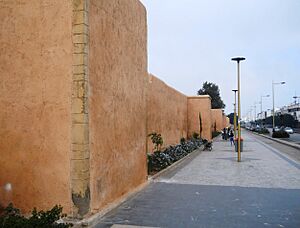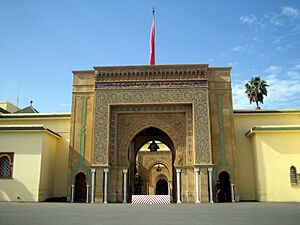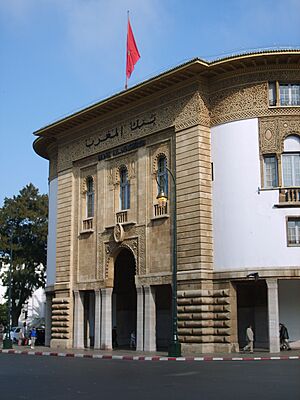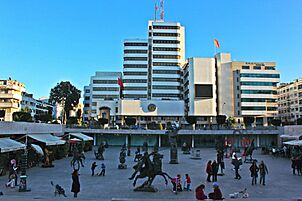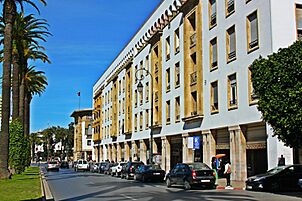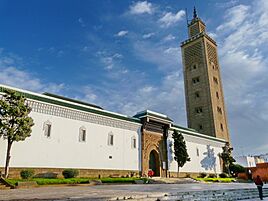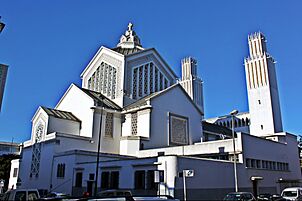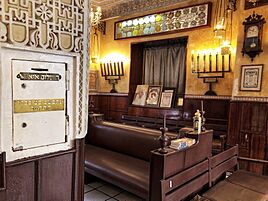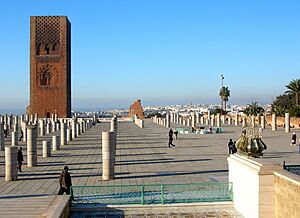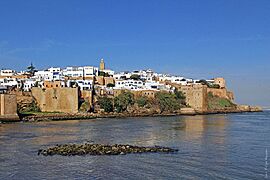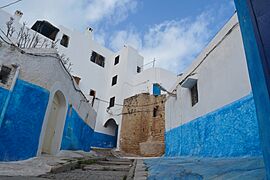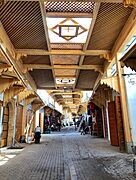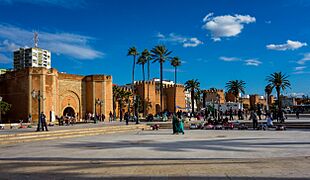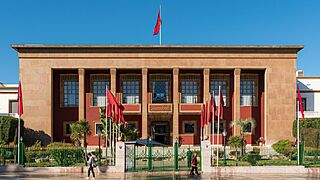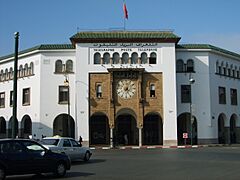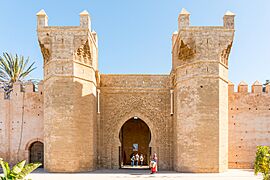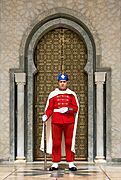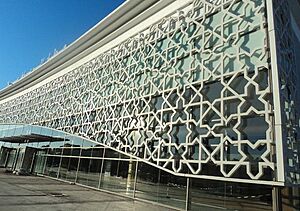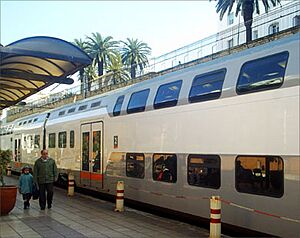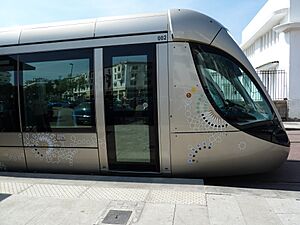Rabat facts for kids
Quick facts for kids
Rabat
الرباط
|
||
|---|---|---|
|
Pictures of Rabat: The Bou Regreg River, Kasbah of the Udayas, Royal Palace, Hassan Tower, Avenue Mohammed V, Chellah Necropolis, and Mausoleum of Mohammed V.
|
||
|
||
| Country | Morocco | |
| Region | Rabat-Salé-Kénitra | |
| Area | ||
| • Capital city | 117 km2 (45.17 sq mi) | |
| Highest elevation | 160 m (520 ft) | |
| Lowest elevation | 0 m (0 ft) | |
| Population
(2014)
|
||
| • Capital city | 1,800,000 | |
| • Rank | 7th in Morocco | |
| • Density | 15,400/km2 (39,800/sq mi) | |
| • Metro | 2,120,192 | |
| Time zone | UTC+1 (CET) | |
| Official name: Rabat, Modern Capital and Historic City: a Shared Heritage | ||
| Type: | Cultural | |
| Criteria: | ii, iv | |
| Designated: | 2012 (36th session) | |
| Reference #: | 1401 | |
| Region: | Arab States | |
Rabat is the capital city of Morocco. It is the country's seventh-largest city. About 580,000 people live in the city itself. Over 1.2 million people live in the wider metropolitan area. Rabat is also the capital of the Rabat-Salé-Kénitra region. It is located on the Atlantic Ocean, where the Bou Regreg river meets the sea. Across the river is Salé, a nearby city.
Rabat was started in the 12th century by the Almohads. After growing for a while, the city went through a long period of decline. In the 17th century, Rabat became a safe place for Barbary pirates. When the French took control of Morocco in 1912, Rabat became their main administrative center. Morocco became independent in 1955, and Rabat was chosen as its capital.
Rabat, Temara, and Salé together form a large urban area. More than 1.8 million people live here. Rabat is one of Morocco's four Imperial Cities. Its old town, called the medina, is a World Heritage Site. You can reach Rabat by train using the ONCF system. You can also fly into the nearby Rabat–Salé Airport.
Contents
What Does the Name Rabat Mean?
The name Rabat comes from the Arabic word a-Ribāṭ. This word means "the ribat", which is an Islamic base or fort. The full name was Ribāṭu al-Fatḥ. This means "the ribat of conquest" or "stronghold of victory". The Almohads gave it this name. They set up the city as a naval base in 1170.
History of Rabat
Early Settlements
Long ago, in the first 1000 years BC, the Phoenicians may have had trading posts here. Later, the area was influenced by Rome. The Romans built a city called Sala Colonia south of today's walled city. This site is now known as Chellah. Digs show older Berber structures were there before the Romans. Sala Colonia was an important Roman naval outpost.
By the 5th century, Sala Colonia was mostly abandoned. When Muslim Arabs arrived in the 7th century, the area became Islamic.
Medieval Islamic Times
In the 10th century, a fortified outpost called a ribat was built here. It was likely on the same spot as the current Kasbah of the Udayas. Around 1030, a new town called Salā (today's Salé) was founded across the river.
In 1150, the Almohad leader Abd al-Mu'min built a new fort (kasbah). It had a palace and a mosque. This Almohad kasbah is the Kasbah of the Udayas we see today. The site became a military base for Almohad armies. They used it before going on campaigns to Al-Andalus (Spain).
Another Almohad leader, Abu Yusuf Ya'qub al-Mansur, started a huge project. He wanted to build a new imperial capital called al-Mahdiyya or Ribat al-Fath. This included a giant mosque, whose remains are the Hassan Tower. He also built grand gates like Bab er-Rouah. But after he died in 1199, the project was never finished. The new city was mostly empty.
During the Marinid dynasty (13th to 15th centuries), Salé became more important. Rabat had only about 100 houses left by 1515. The Marinids did build a Great Mosque in Rabat's old town. They also built a royal burial ground at Chellah.
The Corsair Republic
In 1609, Philip III of Spain ordered all Moriscos to leave Spain. Moriscos were people of Muslim descent. About 2,000 of them settled near Salé and Rabat. They attracted thousands more Moriscos to join them.
In 1627, Rabat and Salé formed the Republic of Bou Regreg. This independent republic became a base for corsairs. These pirates, also called "Salé Rovers", attacked merchant ships in Western Europe.
During this time, the area below the kasbah grew in population. A new "Andalusian Wall" was built. The city on the south bank was called "New Salé". The city on the north bank was "Old Salé". The pirates operated from New Salé.
'Alawi Rule
The pirates continued until al-Rashid conquered the area in 1666. He was the founder of the 'Alawi dynasty. The 'Alawi sultans allowed piracy until the early 19th century. This led to Austria attacking the city in 1829.
The 'Alawi sultans took interest in the city. Moulay Isma'il (1672–1727) expanded the kasbah. He built a royal home there, which is now a museum. He also settled a military tribe, the Udayas, in the kasbah.
Sidi Muhammad ibn 'Abdallah (1757–1790) built a new royal palace. This was the Dar al-Makhzen. These additions made Rabat feel more like a royal residence.
Moulay Slimane (1792–1822) built another palace and new mosques. He also created a Jewish quarter, the Mellah. The city walls were extended significantly to the southwest. By the late 19th or early 20th century, Rabat had about 20,000 to 25,000 people.
Rabat in the 20th Century
French Colonial Rule
France took control of Morocco in 1912. The French administrator, Hubert Lyautey, decided to move the capital from Fes to Rabat. He liked Rabat's coastal location and its closeness to Casablanca.
In 1913, Lyautey hired Henri Prost to design Rabat's modern quarter. This period brought big economic changes and faster city growth. In 1912, Rabat and Salé had about 35,000 to 40,000 people. By 1921, Rabat alone had 33,714 people. Many foreigners moved there. By 1952, Rabat's population grew to about 156,000.
After World War II and Independence
Morocco became independent in 1956. King Mohammed V decided Rabat would remain the capital. The city continued to grow. Many foreign nationals left, and Moroccans took over their jobs. By 1971, Rabat's population was around 368,000.
After World War II, the United States had a military base in Rabat. The U.S. Air Force used it for planes. But after Morocco gained independence, the king asked the U.S. to leave. The U.S. military fully left Morocco by 1963. The base then became a main facility for the Royal Moroccan Air Force.
Rabat has hosted several important meetings. The fifth Arab League summit was held here in 1969. The Organisation of Islamic Cooperation was also founded in Rabat that year. The 1974 Arab League summit recognized the Palestine Liberation Organization. In 1985, the 1985 Pan Arab Games were held in Rabat.
In 2015, Rabat became part of the Rabat-Salé-Kénitra region.
Geography of Rabat
Rabat's Neighborhoods
Rabat is an administrative city with many shopping and residential areas. The city center has three main parts: the Medina (old town), the Oudayas, and Hassan. These are located near the Bou Regreg river and the Atlantic Ocean.
To the west, along the coast, are older neighborhoods like Quartier l'Océan. Further out are working-class areas like Yacoub El Mansour. Hay el Fath is a middle-class neighborhood.
To the east, along the Bouregreg, are areas like Youssoufia (working and middle class) and Hay Nahda (mostly middle class).
Between these two areas are three main neighborhoods. These range from middle-class to wealthy:
- Agdal: A lively mix of homes and shops, mostly for upper-middle-class residents.
- Hay Riad: Known for its wealthy villas. This area has grown a lot since the 2000s.
- Souissi: Has lavish villas, embassies, and is a well-off residential area.
Climate in Rabat
Rabat has a Mediterranean climate. This means it has warm, dry summers and mild, wet winters. Because it's on the Atlantic Ocean, Rabat has a mild, pleasant climate. Winter days are cool, around 17°C. Summer days are warm, usually around 27°C. Nights are always cool. Rabat gets about 560 mm of rain each year.
Culture in Rabat
The biggest place for theater is the Mohammed V Theatre. It opened in 1962. A new performing arts center, the Grand Theatre of Rabat, is being built. It was designed by Zaha Hadid. It is expected to be the largest theater in the Arab world and Africa.
Many groups work on cultural and social issues. An independent art scene is also active. L'appartement 22, the first independent visual arts space, opened in 2002.
Mawazine Music Festival
Mawazine is a big music festival in Rabat. It started in 2001 and is supported by King Mohammed VI. Music groups, fans, and spectators come together for a week of music and culture. Famous musicians like The Weeknd, Jennifer Lopez, and Elton John have performed here.
In 2013, Mawazine had over 2.5 million visitors. The festival is mostly free to attend. Workshops are also available to teach dances and other arts.
Places of Worship
The main places of worship are Muslim mosques. The oldest mosque is the "Old Mosque" in the Kasbah of the Udayas. Other important mosques include the Great Mosque and the As-Sunna Mosque.
Rabat also has synagogues, like the Rabbi Shalom Zaoui synagogue. There are Christian churches too, including St. Peter's Cathedral.
Museums and Parks
The Oudayas Museum is in a building inside the Kasbah of the Udayas. It opened in 1915, making it one of Morocco's oldest public museums. It shows many objects from Moroccan history.
The Museum of History and Civilizations shows Morocco's past through old items. These include Roman statues and Islamic artifacts.
The Rabat Zoo opened in 1973. It houses about 1800 animals. The zoo works to protect animals, including lions descended from the now-extinct Barbary lions.
The Bank al-Maghrib Museum opened in 2002. It has a collection of coins and currency. It also displays Orientalist art. The Mohammed VI Museum of Modern and Contemporary Art opened in 2014.
Historic Monuments
The Kasbah of the Udayas is the oldest part of Rabat. It was built by the Almohads in the 12th century. Later, pirates and the 'Alawi dynasty added to it. Today, it's a residential area with white and blue houses. It also has the "Andalusian Garden."
Rabat's historic walls were first built in the 12th century. They have many grand gates. The most famous is Bab er-Rouah. Other old gates include Bab el-Had and Bab al-Alou. The 17th-century Andalusian Wall has five more gates.
The old medina is below the kasbah. It has many historic mosques and traditional homes. The areas built in the 20th century have public buildings and apartments. These buildings show styles like neo-Moorish and Art Deco. Examples include the Bank al-Maghrib building and the Parliament building.
Overlooking the river is the Hassan Tower. This is a huge, unfinished minaret from the late 12th century. It was part of a giant mosque that was never completed. Across from the tower is the Mausoleum of Mohammed V. This mausoleum holds the remains of King Mohammed V and King Hassan II. It was finished in 1971.
South of the city walls is Chellah. This is an old site with ruins of the Roman city Sala Colonia. It also has a 13th-century Marinid complex. Across the river is Salé, which also has a historic medina.
- Historic sites and landmarks
-
The Kasbah of the Udayas, from the river.
-
Gates of Chellah.
Education in Rabat
Colleges and Universities
- Mohammed V University was founded in 1957.
- National Institute of Statistics and Applied Economics was founded in 1961.
- National School of Architecture (1980).
- HEM Business School, a private school, was founded in 1993.
Transport in Rabat
Air Travel
Rabat's main airport is Rabat–Salé Airport.
Trains
Rabat has two main train stations: Rabat-Ville and Rabat Agdal. They are run by the national rail service ONCF. Trains go south to Casablanca and Marrakech. They also go north to Tangier and east to Fez and Oujda.
The journey to Marrakech takes about 4 hours. To Fez, it's about 2.5 hours on an express train. Casablanca is only 1 hour away.
Tram
The Rabat–Salé tramway was the first tram network in Morocco. It connects Rabat with Salé across the river. It opened on May 11, 2011. The network has two lines and 43 stations. More extensions are planned for the future.
City Buses
A new bus operator, Alsa-City Bus, took over in 2019. They plan to invest a lot in the bus system. They will also bring in many new buses.
Sports in Rabat
Prince Moulay Abdellah Stadium is a large stadium in Rabat. It was built in 1983 and can hold 52,000 people. It is mainly used for football matches. It is also home to the ASFAR (football club) team.
Rabat hosted the 2019 African Games. This was the first time Morocco hosted these games. Rabat is also a possible host city for the 2030 FIFA World Cup.
Football
Rabat's most popular sport is association football. The main clubs are ASFAR and FUS de Rabat. ASFAR has won two major African titles. FUS de Rabat has won one major African title.
Local football teams include:
- ASFAR (football club)
- ASFAR (women)
- FUS de Rabat
- Stade Marocain
- Hilal de Rabat
- Union de Touarga
- Youssoufia Club de Rabat
Handball
- ASFAR
- FUS de Rabat
- Le Stade Marocain
Basketball
Local basketball teams are:
- ASFAR
- FUS de Rabat
- Moghreb de Rabat
- FAR
Volleyball
- ASFAR
- FUS de Rabat
- Crédit agricole Rabat
Famous People from Rabat
- Reuven Abergel, Israeli social activist
- Marc Perrin de Brichambaut, French judge
- Dominique de Villepin, former Prime Minister of France
- David Levy, Israeli politician
- Mohammed VI of Morocco, King of Morocco
- Prince Moulay Rachid of Morocco
- Samira Said, Moroccan singer
- Saad Lamjarred, Moroccan singer
- French Montana, American Hip-Hop Artist
- Younes El Aynaoui, Moroccan tennis player
Sister Cities
Rabat is twinned with these cities:
See also
 In Spanish: Rabat para niños
In Spanish: Rabat para niños


